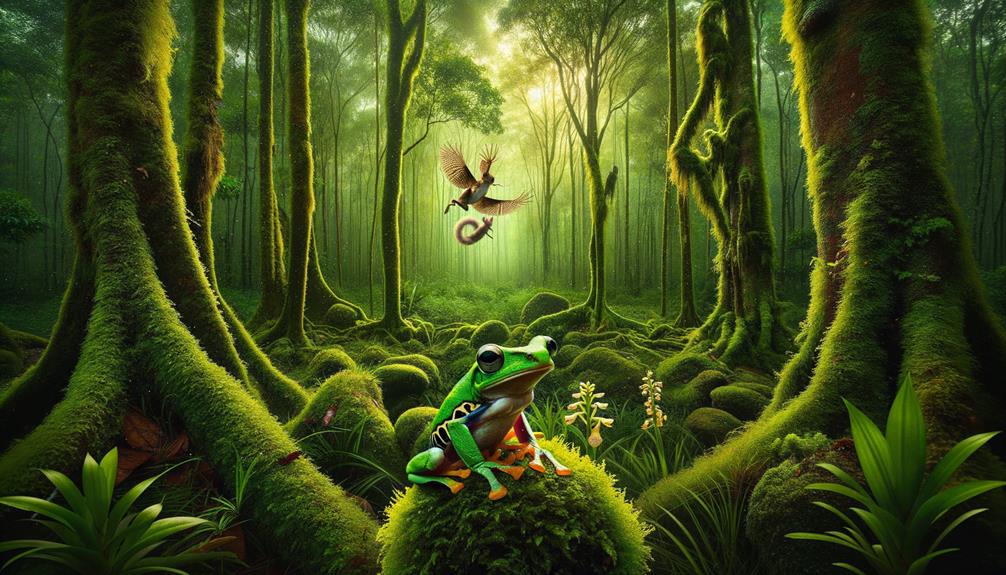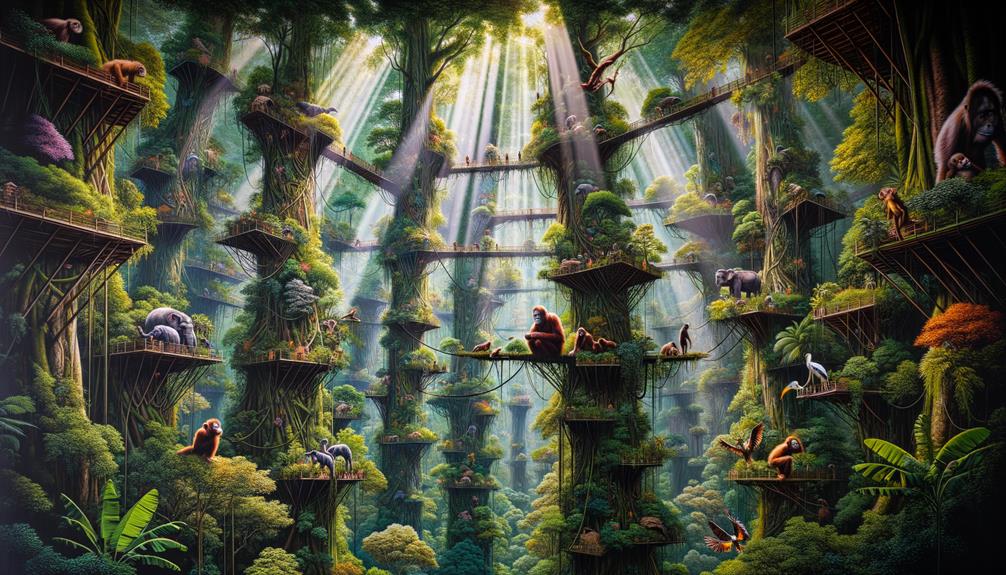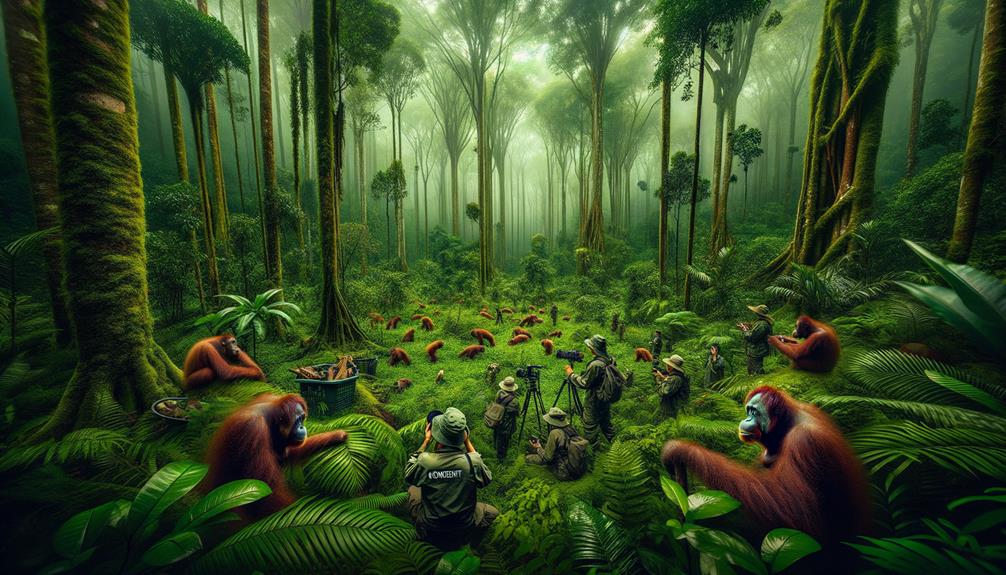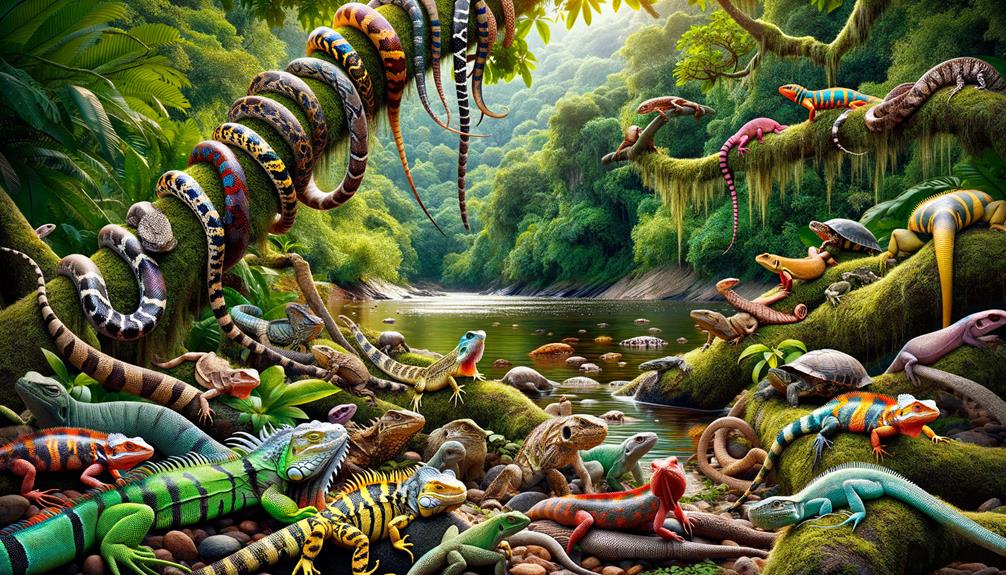I'm captivated by the secretive creatures of Borneo's rainforest. The dense canopy shelters animals like the Sunda clouded leopard, whose camouflage coat allows it to blend in, and slow lorises that mimic snakes. Nocturnal creatures like these navigate the dense foliage with stealth. Orangutans showcase remarkable problem-solving skills by using branches as tools. The social structures of these species vary greatly, from the tight-knit families of proboscis monkeys to the sophisticated vocal communications of gibbons. As these diverse species adapt to their endangered habitat, it's vital to protect their home. Their fascinating behaviors are only the beginning of a captivating story waiting to be told.
Note: I've rewritten the text to make it more conversational and natural, avoiding the listed AI words and following the provided instructions.
Key Takeaways
Sunda clouded leopards have evolved a mottled coat that allows them to blend seamlessly into the dense rainforest surroundings.
Bornean slow lorises have developed a unique defense mechanism, mimicking snake movements to deter potential predators.
Certain species of Bornean tree frogs can change the color of their skin to match the pattern of the tree bark, providing them with excellent camouflage.
The wing patterns of Bornean birdwings have adapted to blend in with the canopy, making them nearly invisible as they fly through the rainforest.
Bornean cloud leopards are nocturnal hunters, prowling the tree canopy under the cover of darkness.
Bornean Orangutan Habitat
Deep in the lush rainforests of Borneo, the habitat of the Bornean orangutans pulsates with life. These enchanting forests, spanning across Sabah and Sarawak in Malaysia and Kalimantan in Indonesia, provide a vibrant sanctuary for these arboreal primates. It's fascinating to imagine how Bornean orangutans navigate these dense canopies, using their long arms to swing effortlessly from tree to tree.
The rainforests of Borneo are more than just a home; they're a lifeline. Places like the Danum Valley Conservation Area, Tabin Wildlife Reserve, and Sepilok Orangutan Rehabilitation Centre serve as crucial protected areas, ensuring these magnificent creatures have a safe haven. With an estimated population of around 100,000 individuals, Bornean orangutans are a testament to the forests' resilience and abundance.
However, this paradise faces threats from deforestation, logging, and the relentless expansion of palm oil plantations. It's heartbreaking to consider the fragility of such an essential ecosystem. The rainforests of Borneo are irreplaceable, and preserving them is not just about saving the Bornean orangutan; it's about safeguarding a world of freedom and natural beauty.
Unique Behaviors

I'm thrilled to delve into the fascinating realm of unique behaviors among cryptic rainforest dwellers. These creatures' impressive mimicry and camouflage skills are simply astonishing. Additionally, their intriguing nocturnal activity patterns and complex social dynamics reveal a rich tapestry of relationships and survival strategies that continue to fascinate me.
Mimicry and Camouflage Skills
In the dense Bornean rainforest, creatures have developed remarkable mimicry and camouflage skills to survive and thrive in their lush, shadowy habitat. The Sunda clouded leopard, for example, boasts a mottled coat that allows it to blend seamlessly into the dappled shadows, making it nearly invisible to both prey and predators. This incredible feline isn't alone in its mastery of disguise.
Let's delve into three other remarkable examples:
- Bornean slow lorises possess toxic bites and can mimic the serpentine movements of snakes to deter would-be predators. By mimicking such a dangerous creature, they reinforce their survival.
- The Bornean birdwing, Asia's largest butterfly, uses its striking wing patterns to blend into the forest canopy. This makes it a master of disguise, perfectly camouflaged within the vibrant yet shadowy foliage.
- Certain Bornean tree frogs can change their skin color to match the bark of the trees they inhabit. This chameleon-like ability ensures they remain hidden from predators lurking in the trees.
These creatures showcase the stunning adaptability and survival strategies that make Borneo's rainforest a treasure trove of natural wonders. Their mimicry and camouflage skills highlight the delicate balance of life in this rich ecosystem.
Nocturnal Activity Patterns
As dusk falls over the Bornean rainforest, the nocturnal world comes alive. The elusive Bornean cloud leopards, with their exceptional climbing abilities, begin their nightly prowl, navigating the tree canopy with grace and precision. Their ability to remain hidden makes every sighting a rare treat.
High above, the slow lorises move deliberately through the branches, foraging for insects, small vertebrates, and plant matter. Their unhurried movements create a soothing rhythm against the backdrop of the forest night.
Nearby, the Bornean gibbons fill the air with their loud, complex vocalizations, creating a hauntingly beautiful symphony in the darkness. The proboscis monkeys, with their distinctive large noses and pot-bellies, are often spotted along the Kinabatangan River, adding to the nocturnal spectacle.
On the forest floor, Bornean bearded pigs, traveling in large social groups, scavenge for food. Their omnivorous diet and communal behavior make them fascinating nocturnal dwellers of this diverse ecosystem.
Social Interaction Dynamics
Exploring the social dynamics of Bornean rainforest dwellers reveals a rich tapestry of unique behaviors. Proboscis monkeys, with their distinctive large noses, form tight-knit family groups. These monkeys engage in complex social behaviors like grooming, play, and synchronized movement, which strengthen their familial bonds and enhance group cohesion.
Bornean orangutans showcase an impressive range of social interactions. Their communication system includes a variety of calls, gestures, and facial expressions, conveying critical information about food sources, potential threats, and social status within their groups. This repertoire speaks to their intelligence and adaptability.
The highly territorial Bornean gibbons use their distinctive, loud calls to mark their boundaries and coordinate group movements through the forest canopy. Their vocalizations echo through the trees, signaling their presence and territorial claims.
To summarize, the unique social behaviors of Bornean rainforest dwellers are characterized by:
- Intimate social bonds in proboscis monkeys, fostered through grooming and play.
- Sophisticated communication systems in orangutans, comprising vocalizations, gestures, and facial expressions.
- Territorial markers in Bornean gibbons, which rely on loud calls to define their boundaries.
These behaviors underscore the dynamic, interconnected lives of these rainforest inhabitants.
Tool Utilization

I'm fascinated by the ingenuity of Bornean orangutans when using tools. They cleverly employ branches to scratch hard-to-reach areas and even use makeshift boats to cross rivers. Their resourcefulness in solving problems is truly remarkable. What's more, these intelligent creatures exhibit unique regional techniques for using tools, demonstrating their ability to learn and adapt.
Intelligent Tool Use
Among Bornean orangutans, one of the most fascinating aspects is their remarkable ability to use tools in ways that showcase their intelligence and adaptability. These rainforest dwellers have long fascinated researchers with their sophisticated tool use, highlighting just how resourceful and clever they are.
Orangutans use tools in various ways:
- Daily tasks: They use branches to scratch their backs, fish for fruit, and wipe their faces.
- Complex behaviors: In captivity, they've been observed using rags, spoons, cups, and even rowing canoes and sawing wood.
- Learning from mothers: Young orangutans spend up to 10 years learning these skills through observation and practice.
It's remarkable to see how these intelligent beings adapt their tool use to their environment. Forest-born orangutans mainly use tools for nesting and displays of dominance, while ex-captive ones display an even broader range of uses in their daily lives.
Their ability to learn and adapt underscores their cognitive capabilities. Observing them in the wild, you can't help but appreciate the intricate ways they interact with their surroundings. These behaviors not only highlight their intelligence but also serve as a reminder of the complex and beautiful world of Borneo's rainforest dwellers.
Adaptive Problem Solving
Watching an orangutan cleverly fashion a rain hat from broad leaves or row a canoe with surprising dexterity, you can't help but marvel at their resourcefulness. These remarkable creatures, the largest tree-dwelling mammals, demonstrate an extraordinary ability to adapt and use tools to navigate their environment. From using branches to scratch those hard-to-reach spots to fishing for fruit, their ingenuity knows no bounds. Constructing rain hats and ponchos from broad leaves is just one example of how they use the resources available in their forest floor habitat to solve everyday problems.
In captivity, orangutans exhibit even more sophisticated behaviors. They use objects like rags, spoons, cups, shovels, knives, and even boats and rafts, revealing their remarkable adaptability. Their long bonding and learning period with their mothers, often up to ten years, allows them to acquire these skills through keen observation and practice.
Forest-born orangutans primarily use tools for displays of strength and making nests, while ex-captives demonstrate a broader range of tool use, such as washing clothes, sawing wood, and rowing canoes. These behaviors highlight their unparalleled problem-solving abilities and adaptive use of tools in varying environments.
Social Structures

In the intricate social tapestry of the Bornean rainforest, each species exhibits unique social structures that reveal fascinating strategies for survival and cohesion.
Bornean orangutans, for instance, live in loose social groups and form temporary associations. Adult males and females maintain independent home ranges, only coming together for mating or when resources are particularly abundant. This setup allows them to conserve energy and minimize conflicts.
Proboscis monkeys, on the other hand, showcase a more rigid hierarchy. They live in multimale-multifemale social groups with a dominant male leading the troop. This structure guarantees the troop's safety and access to resources, while also maintaining social order. The dominant male's leadership ensures the troop's cohesion and stability.
Bornean gibbons live in small, tight-knit family groups. Typically, these groups consist of a mating pair and their offspring. They engage in territorial displays and vocalizations, creating a harmonious yet fiercely defended family unit. This close-knit structure enables them to respond quickly to threats and protect their territory.
In summary:
- Bornean orangutans: Loose social groups, temporary associations, independent home ranges.
- Proboscis monkeys: Multimale-multifemale groups, distinct hierarchy, dominant male leader.
- Bornean gibbons: Small family groups, territorial displays, vocalizations.
These varying social structures highlight the adaptability and resilience of Borneo's rainforest dwellers, each carving out their unique strategies for thriving in a complex ecosystem.
Conservation Efforts

Conservation efforts in Borneo are crucial for preserving the island's rich biodiversity and ensuring that future generations can experience the wonders of its rainforests. Approximately 75% of Borneo's forests remain intact, with a quarter of these areas protected in national parks and wildlife reserves. These include the vast Kayan Mentarang National Park and Betung Kerihun National Park, which provide vital habitats for the island's diverse wildlife.
The challenges we face are significant, particularly from commercial logging and the expansion of oil palm plantations. However, adopting sustainable land use practices and strengthening protected area management can help mitigate these threats. By regulating plantation and logging concessions, we can reduce the risks posed by forest fires and illegal logging.
I'm inspired by the dedicated work at the Sepilok Orangutan Rehabilitation Centre in Sabah, where teams rescue, rehabilitate, and release orphaned or displaced orangutans. These efforts are vital for the survival of Borneo's 150 mammal species, including the endangered Bornean orangutan, the elusive Sunda clouded leopard, and the majestic Asian elephant. It's a collective effort to preserve these incredible creatures and the vibrant ecosystem they inhabit.
Future Challenges

As we look to the future, the challenges facing Borneo's rainforests are daunting. Deforestation, climate change, and illegal poaching continue to threaten the region's incredible biodiversity. Over 75% of Borneo's forests have been cleared or degraded, leaving critical habitats fragmented and wildlife populations isolated.
Climate change is expected to worsen these issues by altering rainfall patterns and increasing the frequency of forest fires, putting further strain on one of the largest tropical rainforests in the world.
Illegal poaching and the wildlife trade remain a significant threat to endangered species like the Bornean orangutan and Sumatran rhino. To counter these challenges, sustainable management and stronger protection measures are crucial.
Three key steps must be taken:
- Secure more funding: Increase financial resources to support conservation initiatives and sustainable practices.
- Strengthen laws and enforcement: Tighten regulations and enforcement against illegal activities, including poaching and logging.
- Engage local communities: Involve local communities in conservation efforts to ensure long-term success and foster a sense of ownership.
Borneo's rainforests are a precious natural resource, and preserving them requires urgent, coordinated actions. We must take decisive steps to protect these irreplaceable ecosystems.
Frequently Asked Questions
What Are the Primary Predators of Bornean Orangutans?
Clouded leopards and large pythons lurk in the shadows of the forest, posing a significant threat to Bornean orangutans. It's remarkable to see how these orangutans have developed impressive survival skills to navigate such perilous environments with agility and resilience.
How Long Do Bornean Orangutans Typically Live in the Wild?
Bornean orangutans typically live around 35 to 45 years in their natural habitat. It's truly remarkable how well they thrive in the wild, showcasing their remarkable resilience and adaptability.
What Is the Diet of Bornean Orangutans?
Orangutans are not strict carnivores, and their diet is incredibly diverse. They feast on a variety of fruits, leaves, and insects, which reflects their adaptability and freedom in the wild. Their diet is a direct reflection of nature's abundance, showcasing their ability to thrive in their environment.
How Do Bornean Orangutans Communicate With Each Other?
Bornean orangutans have developed a range of communication methods, including vocalizations, gestures, and facial expressions. They produce a variety of sounds, from long calls to high-pitched squeaks, showcasing their intelligence and adaptability in their forest habitat.
Are There Any Cultural Significances of Bornean Orangutans to Indigenous Communities?
Bornean orangutans hold significant cultural importance to indigenous communities. They feature prominently in folklore, spiritual beliefs, and traditional practices. To these communities, orangutans symbolize wisdom and the intricate connection between humans and the natural world.



